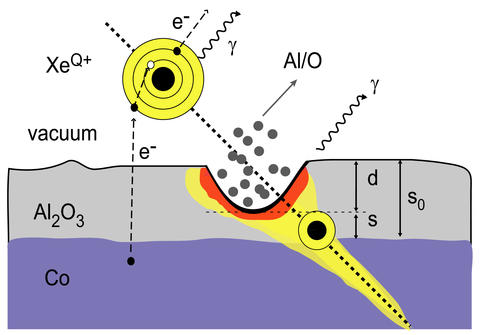
A schematic detailing the various ways that the energy of highly charged ions is dissipated during an impact. Approximately 60 percent of the ions energy is blown back and, according to NIST measurements, 27 percent of the remaining 40 percent goes into deforming the material-making a crater or "divot".
Much like a meteor impacting a planet, highly charged ions hit really hard and can do a lot of damage, albeit on a much smaller scale. And much like geologists determine the size and speed of the meteor by looking at the hole it left, physicists can learn a lot about a highly charged ion's energy by looking at the divots it makes in thin films.
Building upon their work for which they were recently awarded a patent,* scientists at the National Institute of Standards and Technology (NIST) and Clemson University have measured the energy of highly charged ion impacts on a thin film surface for the first time in detail.** Understanding how ions discharge their energy upon impact will help researchers to make better predictive models of how the particles affect surfaces.
The question isn't trivial. Ions are used in exactly that way for a variety of micro- and nanoscale production processes, techniques such as ion milling and etching. Better predictive models may also help researchers curtail ionic erosion where it would be a bad thing, such as inside a fusion reactor.
The research team used xenon atoms from which they had stripped all but 10 of the atoms' original 54 electrons. Making an atom so highly ionized takes a lot of energy—about 50,000 electron volts. The atom soaks up all the energy that went into freeing the electrons until it is capable of imparting more energy, and thus more damage, than could be done with kinetic energy—mass and speed—alone.
"When the highly charged ion is finally released and hurtles into its target, most of its energy, about 60 percent, blows back in the 'splash' and dissipates into the vacuum," says Josh Pomeroy. "According to our measurements, 27 percent of the remaining 40 percent of the ion's energy goes into changing the shape of the material—making divots."
Pomeroy says that the remaining 13 percent is most likely converted to heat.
The group first began looking into nanoscale pitting of thin films to help improve the performance of data storage hard drives, which used aluminum oxide thin films as an insulator between magnetic plates. They used ions to pockmark the surface of these films and showed that the depth of the pitting could be determined by measuring minute changes in electrical conductance through the film.
The original motivation for the work has abated, but the group's method and materials remain useful for measuring the energy transfer of highly charged ions and calibrating industrial systems using high-energy ion beams.
* United States Patent 7,914,915, "Highly charged ion modified oxide device and method of making same." Inventors: J.M. Pomeroy, H. Grube and A. Perrella. Issued March 29, 2011.
R.E. Lake, J.M. Pomeroy, H. Grube and C.E. Sosolik. Charge state dependent energy deposition by ion impact. Physical Review Letters. August 5, 2011. http://prl.aps.org/abstract/PRL/v107/i6/e063202.

